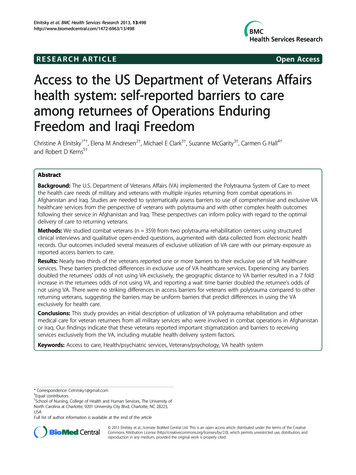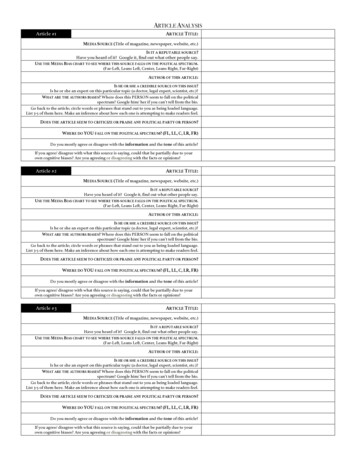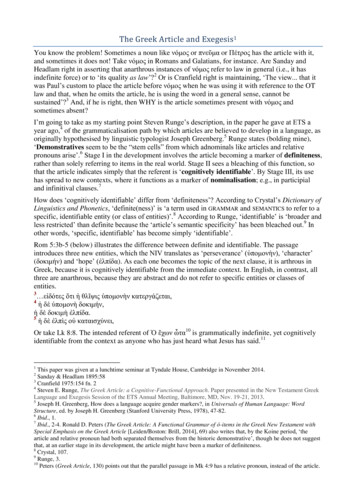
Transcription
Elnitsky et al. BMC Health Services Research 2013, 8RESEARCH ARTICLEOpen AccessAccess to the US Department of Veterans Affairshealth system: self-reported barriers to careamong returnees of Operations EnduringFreedom and Iraqi FreedomChristine A Elnitsky1*†, Elena M Andresen2†, Michael E Clark3†, Suzanne McGarity3†, Carmen G Hall4†and Robert D Kerns5†AbstractBackground: The U.S. Department of Veterans Affairs (VA) implemented the Polytrauma System of Care to meetthe health care needs of military and veterans with multiple injuries returning from combat operations inAfghanistan and Iraq. Studies are needed to systematically assess barriers to use of comprehensive and exclusive VAhealthcare services from the perspective of veterans with polytrauma and with other complex health outcomesfollowing their service in Afghanistan and Iraq. These perspectives can inform policy with regard to the optimaldelivery of care to returning veterans.Methods: We studied combat veterans (n 359) from two polytrauma rehabilitation centers using structuredclinical interviews and qualitative open-ended questions, augmented with data collected from electronic healthrecords. Our outcomes included several measures of exclusive utilization of VA care with our primary exposure asreported access barriers to care.Results: Nearly two thirds of the veterans reported one or more barriers to their exclusive use of VA healthcareservices. These barriers predicted differences in exclusive use of VA healthcare services. Experiencing any barriersdoubled the returnees’ odds of not using VA exclusively, the geographic distance to VA barrier resulted in a 7 foldincrease in the returnees odds of not using VA, and reporting a wait time barrier doubled the returnee’s odds ofnot using VA. There were no striking differences in access barriers for veterans with polytrauma compared to otherreturning veterans, suggesting the barriers may be uniform barriers that predict differences in using the VAexclusively for health care.Conclusions: This study provides an initial description of utilization of VA polytrauma rehabilitation and othermedical care for veteran returnees from all military services who were involved in combat operations in Afghanistanor Iraq. Our findings indicate that these veterans reported important stigmatization and barriers to receivingservices exclusively from the VA, including mutable health delivery system factors.Keywords: Access to care, Health/psychiatric services, Veterans/psychology, VA health system* Correspondence: Celnitsky1@gmail.com†Equal contributors1School of Nursing, College of Health and Human Services, The University ofNorth Carolina at Charlotte, 9201 University City Blvd, Charlotte, NC 28223,USAFull list of author information is available at the end of the article 2013 Elnitsky et al.; licensee BioMed Central Ltd. This is an open access article distributed under the terms of the CreativeCommons Attribution License (http://creativecommons.org/licenses/by/2.0), which permits unrestricted use, distribution, andreproduction in any medium, provided the original work is properly cited.
Elnitsky et al. BMC Health Services Research 2013, 8BackgroundSince 2002, over 2.3 million Americans have been deployed in support of the wars in Afghanistan or Iraq(commonly called Operation Enduring Freedom andOperation Iraqi Freedom [OEF-OIF]). Of that total, over1 million returnees have accessed services through theUS Department of Veterans Affairs (VA) Veterans HealthAdministration. The VA is the single largest healthcareprovider for this population of veterans. Many veterans ofAfghanistan and Iraq have experienced exposure to blastsand explosions, resulting in multiple complex injuries tobody systems, emotional distress and mental disorders,[1,2] and pain [3-5]. These multiple injuries to two ormore body systems or parts resulting in physical, psychological, cognitive or other psychosocial impairments havebeen designated “polytrauma” by the VA. Among OEFOIF war veterans, there also is a high prevalence of PostTraumatic Stress Disorder (PTSD) [1,2,6] which often occurs in tandem with pain [7].To meet the needs of returning veterans and militarywith polytraumatic injuries, VA implemented the Polytrauma System of Care which currently is composed offive Polytrauma Rehabilitation Centers (PRC), 23 Polytrauma Network Sites (PNS), and more than 130 supportsites with Polytrauma Support Clinical Teams or Points ofContact. PRCs provide comprehensive, acute inpatientrehabilitation, and PNSs provide interdisciplinary, postacute rehabilitation services [7]. In addition to veteranswho are registered with these care centers, the VA createda registry of Veterans returning from Afghanistan andIraq, called the Operation Enduring Freedom and Operation Iraqi Freedom (OEF-OIF) registry, to provide criticalinformation for concurrent care and consultation acrossmultidisciplinary experts. Both of these veteran trackingsources were used in the present study, combining a broadspectrum of veterans of OEF-OIF including those withdesignated polytrauma, and others with complex healthservice needs.While veterans of both OEF-OIF systems are eligibleto use VA healthcare services for several years followingtheir return, they may face barriers to seeking care beyond the cost of health care services. For example, veterans of these wars have reported the stigma of mentalillness or being a burden to the system as barriers toseeking care [1,8]. While addressing barriers to use ofmental health services in this OEF-OIF population is apriority, it is important to recognize that these veteranshave other serious needs requiring the use of a broaderrange of services, and that they might seek or receivethese services outside of the VA. Continuity of qualityhealthcare and reduced cost are both enhanced from exclusive use of VA healthcare, and understanding whyveterans choose or are limited in exclusive VA care isessential.Page 2 of 10We found no studies that addressed barriers to use ofcomprehensive and exclusive VA healthcare services fromthe perspective of veterans of OEF-OIF with polytrauma.One qualitative study described polytrauma rehabilitationand its impact on providers and identified potentialprovider-perceived barriers at VA PRCs [9]. Other studieshave examined military service member perceptions ofbarriers to military mental health services [1] or veteranperceptions of barriers and facilitators to mental healthcare [10,11] and PTSD treatment in particular [8]. Healthsystem barriers to care such as long wait times and longdistances to treatment facilities reduce veterans’ ability toaccess care [12] and this has important implications fordiscontinuities in utilization of mental health and nonmental health services [13]. Thus, a more comprehensiveview of access is important to understanding the issue ofbarriers to care.Our research question was theory-driven. The Behavioral Model of Health Care Utilization is the leadingframework for examining predictors of health care use,and is especially well suited to understanding VA carefor OEF-OIF veterans. This model considers health caresystem, population, and societal and external environment factors that predict health care service use [14,15].The health care system organization determines a person’s use of services, such as PRC or OEF-OIF Registry[15]. Three sets of population factors contribute to anindividual’s propensity to use health care services: predisposing, enabling, or need [15]. Predisposing factorsexist before the onset of injury, such as demographics.Enabling resources, such as income and insurance, impede or enhance access to care. The need for servicesincludes diagnoses or symptoms. Barriers, factors thatmake it difficult to receive services, intervene betweenthe delivery system and its utilization [16,17]. While anumber of researchers have applied this model to thestudy of VA health service use in general, and PTSD inparticular, we know of no studies examining the utilityof this framework to explain the impact of delivery system, population characteristics, and barriers on exclusiveuse of VA services among veterans with polytrauma. Agraphical representation of our adapted operational modelis shown in Figure 1. Our approach modeled barriers forveterans using all their health care from the VA amongthose using any VA care. This approach included attentionto variation in practice associated with different geographical regions and different VA organizations.MethodsSetting/sampleTwo of four US VA facilities with regional inpatientPolytrauma Rehabilitation Centers (PRCs) participatedin this study; the fifth currently designated PRC was notactive at the time of this study. PRC sites treat the
Elnitsky et al. BMC Health Services Research 2013, 8Health Delivery SystemOrganization StructureRegistry groupPolytrauma Network SystemSocietal DeterminantsNorms - StigmaExternal EnvironmentNegative Enabling – BarriersPage 3 of 10Population Marital StatusEnablingEmploymentNeedExposure to combat, blastsMental health problemsUse of Health ServicesSite - VAFigure 1 Model of VA service utilization.greatest number and most complex active duty and retiredservice members seeking or receiving VA healthcare services and serve as primary components of the VA Polytrauma Network System (PNS). The study facilities, onenorthern and one southeastern, are both large, tertiarycare VA hospitals that provide a broad range of medicaland mental health care. Both also maintain a comprehensive list (OEF-OIF registry) of current or former servicemembers who have applied for local VA services. Participants we recruited were military personnel deployed during OEF- OIF who were either receiving or had registeredfor (but might not have used) VA healthcare. Includingparticipants from both locations’ facilities’ increased regional and ethnic heterogeneity of the sample of OEF-OIFreturnees and enriched the ability of the analyses to reflectthe changing nature of the definition of polytrauma andthe veterans experiencing it.Participants were recruited from either the OEF-OIFregistry (Registry group) or the PNS (PNS group) at thetwo study sites. Eligibility for the study required that allstudy participants were deployed to Afghanistan or Iraqbetween October 2001 through September 2010, capableof reading and writing English, and were judged competent by their providers to provide informed consent. OEFOIF registry participants were randomly selected from facility lists and recruited using a three-stage process of amailed letter of study introduction, telephone invitationand information for full screening, and a face-to-face consent procedure. PNS participants were recruited directlyfrom the two local polytrauma programs. Participantswere eligible for enrollment at any point during theirtreatment, including hospitalization. In addition to meeting the overall study inclusionary criteria, PRC patientshad to: attain a Rancho Los Amigos [12,18] (a scale ofcognitive impairment routinely used in PRCs) level of 6or greater (minimal to moderate impairment) and receive attending physician clearance to participate. Because the cognitive status (thus study eligibility) of PRCresidents often improved dramatically during theirinpatient rehabilitation stay, study staff reviewed medical records and progress notes periodically to determine if and when they met study inclusionary criteria.A summary of the recruitment process and associatedattrition has been presented elsewhere [5]. Because theregistry includes many people whose location changedafter their initial entry and could not be located withinthe constraints of this project, and because registryeligibility was fluid when we sampled, we only includepeople we spoke to directly as the potential respondents. A total of 359 participants (218 Registry; 141PNS) completed baseline assessments. Participants received a 30 incentive on completion of the baseline assessment session to offset time investments and travelexpenses. The University of South Florida InstitutionalReview Board and the Minneapolis VA Medical CenterSubcommittee on Human Studies and each VA MedicalCenter’s Research and Development committee approvedthe study prior to recruitment and data collection.MeasuresAs noted, we selected model covariates, applying theAndersen behavioral model of factors influencing utilization [14,19]. Figure 1 provides specific factors includedin our study. We measured mental health problems asself-reported in structured clinical interviews. This interview was an expansion of one developed in 2005 to identify pain and emotional symptoms in returning soldiers[20]. Service connection (as a percentage degree of impairment) was reported as recorded in the VA electronicmedical record. Service connection indicates whether thereturnee was certified as disabled and was eligible for benefits to compensate for disorders incurred or aggravatedduring military service [21]. Many returnees with psychiatric diagnoses are classified as service connected, meaning they have priority for VA healthcare services andreceive financial disability compensation from VA.We categorized returnees’ psychiatric diagnoses typebased on a number of instruments. Diagnoses were
Elnitsky et al. BMC Health Services Research 2013, 8established by in-person clinical interviews utilizing theMini International Neuropsychiatric Interview (M.I.N.I.version 5.0). The M.I.N.I. is a brief, validated, structuredclinical interview designed to yield reliable Axis I DSMIV psychiatric diagnoses. [22] It has been validatedagainst versions of the Structured Clinical Interview forDSM diagnoses (SCID-P) and the Composite International Diagnostic Interview for ICD-10 (CIDI) [22].We used the M.I.N.I to identify Major Depressive Disorder and PTSD diagnoses. The Center for EpidemiologicStudies-Depression Scale (CES-D) 20-item measure wasused to identify depressive symptomatology [23,24]; itcomplements the M.I.N.I major depressive disorderdiagnosis measure used in this study. The Dyadic Adjustment Scale, Short Form (DAS-SF) 7-item measureof marital adjustment and marital quality discriminatesbetween distressed and adjusted relationships and wasused as an index of relationship distress in study participants [25].Utilization of VA care was characterized by severalvariables. First, participants were asked if they had received pain treatments or mental health treatments fromVA in the last 3 months. Following several probes describing those treatments, participants were asked if theywere using VA for all medical services (yes, no). Studyparticipants were also asked if they were planning to useVA services, and if not planning to use VA we asked forthe reasons (why not). These were recorded as text, andsubsequently coded into one of 10 categories, as described below.In the Behavioral Model, [14] access to care representsan enabling factor influencing utilization and access barriers represent negative enabling factors. We selectedqualitative methods to identify a broad range of barriersthat were meaningful to the OEF-OIF veteran participants. Barriers to care were derived from one open-endedquestion asked of veterans, “What might be barriers to receiving care at the VA?” One team member (SG) codedthese responses into categories, and two additional investigators independently coded, then reviewed together theresulting codes. Each respondent was asked to identify upto three barriers to care. Responses were coded into tenvariables (Barriers) as “present” or “not present”. Each barrier type was coded as present or absent if it appeared inany of the three responses, and we also constructed a variable with a total count of barriers and coded a binary outcome (0, or 1–3 barriers).AnalysesWe posed primary hypotheses based on gender and bycare system (Registry and PNS) using independent t testsfor continuous or quasi-continuous data, and Chi-Squaretests for categorical data. In these analyses no correctionfor multiple comparisons was employed as our primaryPage 4 of 10aim was to identify characteristics of the sample of potential interest to readers.By using theory-based model building, we acknowledgedthe different VA facilities and were attentive to variationin practice that might exist in different geographic regions.We conducted exploratory regression models examininggroups of predictors of barriers to exclusive use of VA carebefore using these variables in our models of healthcareutilization. There are theoretically three groups of VA veteran health care users, those who exclusively use, thosewho use some, and those who use none of the availableservices. Overall, we examined barriers to the exclusiveuse of VA care (yes/no). Organization of VA care suggested two specific system barriers that we examined inmore detail. These two barriers were distance to the facility, and wait times to care. We also constructed a modelusing a summary variable of specific various factors classified as any barrier compared to no reported barrier. Covariates in all three models were selected from thecommon key barriers that emerged from descriptive andmodel building analysis phases [26].We computed the odds ratio (OR) and 95% confidenceintervals (CI) to examine the association of specific, andany barriers with utilization of exclusive use of VA healthcare using binomial logistic regression. Our final modelsfor each individual (and a summary measure) barrier variable include a parsimonious set of covariates. We includedage and gender, and then tested and included potentialconfounders (e.g., employment, mental health) if they produced a meaningful change in the OR for our veterangroup of 10% or more. All analyses were conducted usingSPSS (version 19).ModelsOther predictor variables (health system; predisposing, enabling, need characteristics) were tested within groups,then we tested for a parsimonious final model (forcing inhypothesized variables, such as gender and registry) [26].To examine the extent to which care system and otherfactors explain the number of barriers experienced toexclusive use of VA care, we conducted a progressiveseries of linear regressions. For each regression, we entered measures that contributed to use (e.g., system ofcare, predisposing variables such as age, gender, maritalstatus, and type of service). We excluded variables frommultivariate models when the regression coefficient forgroups did not change (data available from authors). Wethen examined the impact on utilization for any barriersand then looked separately at those with variability andsufficient frequency to test in utilization models (i.e.,geographic distance, and wait time barriers).To examine the extent to which barriers to VA care influence actual use of VA health care, we next conducted aseries of logistic regressions in which we examined the
Elnitsky et al. BMC Health Services Research 2013, 8unique contribution of care system and other factors toVA use. For each logistic regression model, we enteredpreviously documented population characteristics thatcontributed to use (e.g., age, gender, marital status; enabling factors such as education, employment). Major differences between groups on barriers and the direction ofrelationship seemed to indicate a relationship to injuriesso we added an Anderson model “need” characteristic tothe models (depression as measured by the M.I.N.I. orever had a mental health problem [yes/no]).ResultsDescriptive characteristicsOf the 359 participants, 218 (60.7%) were recruited fromthe local OEF-OIF site registries (Registry) and 141(39.3%) originated from the two local VA PNS sites. Thedemographic characteristics of the overall sample andthe two VA PNS sites are summarized in Table 1. Theaverage age of participants was relatively high (35.1 years)and ranged from 20 to 66 years. Women constituted 7.9%of the sample, equal to the current US women veteranpopulation [27] but slightly under-representing VA HealthCare registration data for OEF and OIF veterans [28]. Theethnic and racial distribution of the sample reflected anoverrepresentation of Hispanics (10.6%) when comparedwith the veteran population (5.9%) and underrepresentation of Blacks (9.5%) when compared with the overall USveteran population (11.4%).[27] The majority of participants were married (52.4%), had completed their serviceobligations, and were employed full time (61.8%). Theaverage length of deployment to OEF-OIF was approximately 15 months, 80.2% reported they had been exposedto blasts, and 65.2% were receiving VA benefits for serviceconnected conditions.Barriers to VA care are reported in Table 1. The majority of participants (62.4%) reported concerns aboutstigmatization and at least one barrier to VA care. Barriers to VA care reported by participants and categorizedby investigators included: (a) Wait times (26.7%); (b) concerns about staff /reputation for care (15%); (c) fear/embarrassment/stigma (13.9%); (d) distance/location (12%);(e) paper work/hassle (10.3%); (f) lack of informationabout services (9.5%); (g) limited hours for services (3.3%);(h) veteran had other insurance/monetary support/orprivate doctor (3.3%); (i) fear of military accessing healthrecords (1.7%); and (j) on active duty (1.4%). Both VA caregroups generally perceived an equivalent average numberof barriers (about 1.1 or 1.2 barriers). For both groups ofparticipants, the most likely barrier to VA care was waittimes; the least reported barriers and stigma were havingother insurance for PNS participants, and for the OEFOIF registry group, active duty status and fear of the military accessing their health records. Wait times, reportedby participants in open-ended barrier items, included aPage 5 of 10variety of types, for example, “wait times for appointmentsare very long”, or “get seen quicker in private facility”.Distance/ location barriers were described in terms ofneeding to be “closer to home,” or “not being close by45 minutes away.”There were minor differences in the barriers andstigma we tested and none were statistically significant.While we were concentrating on the experience of threedichotomous categories of any barrier plus the two primary system barriers, we conducted ad hoc exploratoryanalyses of outcomes with models including other specific barriers that are descriptively shown in Table 1.As the utilization characteristics indicate, a slight majority of participants (53%) were currently receiving VAtreatment. PNS participants were more likely to have received pain treatment (52.5%), mental health treatment(61.4%), or all health services (67.6%) from VA in the last3 months than OEF/OIF registry participants.The multivariate logistic regression models providedmore detailed results about the association between twospecific barriers among OEF-OIF returnees and exclusive use of VA for their care. As noted above, we focusedon three barriers in the multivariate models: we examined the presence of any reported barrier, and then twospecific VA health delivery system barriers; wait times,and distance location. Table 2 presents the summary offinal models of each of the multivariate models of barriers. Because the three models have similar estimates,we provide only the final model in our results section.The individual model constructions with progressive additions of blocks of variables based on the Andersenmodel are available on line as Additional files 1, 2 and 3.As shown in Table 2, we report three models, one oneach of the major barriers (i.e., any barriers, distance orlocation barrier, and wait time barrier). All three majorbarriers maintained significant associations with the exclusive use of VA care outcome, after accounting for previously documented health delivery system and populationcharacteristics. In the final model examining the relationship with any barrier we found Veterans who experiencedany barriers had double the odds of not using VA care exclusively. Veterans who experienced distance or locationbarriers, that is how far they are from a VA facility, had 7fold increased odds of not using VA care exclusively.Veterans who experienced wait time barriers had doublethe odds of not using VA care exclusively.DiscussionThis study assessed barriers to use of exclusive VAhealthcare services among veterans of OEF and OIF whowere on active duty or discharged military personnel ofall military services who were either receiving or registered for VA health care. However, we found almost twothirds reported one or more barriers to receiving VA
Elnitsky et al. BMC Health Services Research 2013, 8Page 6 of 10Table 1 Descriptive characteristics of 359 veterans of operation enduring freedom (OEF) or operation Iraqi freedom(OIF) VariablesAll veterans N 359PNS n 141OEF/OIF n 21835.1 years32.9 years36.6 years91.1%92.9%89.9%Predisposing characteristicsMean age (range 20–66) §§§Gender (% men)Marital statusNever married24.2%26.2%22.9%Married52.4%48.9%54.6%Living as 7%14.5 years13.8 years14.9 yearsWhite lack non-hispanic9.5%9.2%11.5%Other 16.1%Unemployed looking for work11.1%9.9%11.9%Other non-working10.5%15.9%6.9%Mean years of education §§§Race/ethnicity§Employment§§§EmployedDuty status at baseline §§§Active duty11.7%20.6%6.0%Inactive reserve10.6%13.5%8.7%Active reserve20.9%23.4%19.3%Temporary duty release1.7%2.8%0.9%Completed service55.2%39.7%65.1%Any Army49.1%50.3%48.2%Any Navy8.1%5.7%9.6%Service branch (any service in each branch) §Any Air Force8.7%4.2%11.5%Any Marine11.2%14.9%8.8%Any National Guard24.3%26.9%22.5%65.2%73.8%59.6%OEF/OIF deployment months (range 0–65 months) §14.6 months15.9 months13.8 monthsMonths since return (range 0–135 months) §§§42.4 months34.1 months47.8 monthsEnabling characteristicsService connected (self report)ExposuresGulf War tours12.0%9.3%13.8%Exposed to blast §§§80.2%94.3%71.1%67.2%87.9%53.7%CESD† scale mean18.623.215.5Dyadic adjustment scale score (mean)22.421.423.126.5%44.7%14.7%Need characteristicsEver had a mental health problem (self report) §§§PTSD diagnosis (y/n) §§§
Elnitsky et al. BMC Health Services Research 2013, 8Page 7 of 10Table 1 Descriptive characteristics of 359 veterans of operation enduring freedom (OEF) or operation Iraqi freedom(OIF) (Continued)Major depressive disorderdiagnosis .1%71.6%51%Any perceived barrier62.4%63.8%61.5%Wait times26.7%23.4%28.9%Staff concerns/reputation15.0%16.3%14.2%VA health system geographic location §Barriers to VA %10.6%Lack of services information9.5%10.6%8.7%Limited services hours3.3%5.0%2.3%Other insurance/money/private MD3.3%1.4%4.6%Fear military records access1.7%2.8%0.9%Active duty1.4%2.8%0.5%1.1 ( 1.1)1.2 ( 1.1)1.1 ( 1.1)VA current treatment §§§53.0%65.9%40.3%VA pain treatment last 3 months §§§37.8%52.5%28.2%VA mental health treatment last 3 months §§51.6%61.4%41.7%All VA services in last 3 months §§§53.2%67.6%44.0%Community pain treatment received last 3 months23.6%24.6%23.0%Total barriers (0–3) mean standard deviation(SD) Among all veterans, 0 barriers 37.6%;1 28.1%; 2 18.3%; 3 15.8%UtilizationCommunity mental health treatment 3 months15.3%16.9%13.6%In- patient §§§15.1%28.4%6.5%VA treatment received last 3 months §§§61.8%47.5%71.1%Community treatment received last 3 months §§§40.9%26.2%50.5% OEF-OIF returnees from PNS is Polytrauma Network System; other OEF/OIF returnees from Registry.§ p 0.05§§ p 0.01 §§§ p 0.001 Tests between PNS and OEF/OIF groups (means, percentages).† Center for Epidemiologic Studies Depression (20 item) scale.care. Both the OEF-OIF and the PNS groups describedbarriers that hindered receiving exclusive VA care. Theseveterans reported that barriers included wait times, distance to the VA facility, concerns about VA staff reputation, paperwork hassle, lack of information, limitedservice hours, fear/embarrassment/stigma, and havingother insurance.Both those in the OEF-OIF and the PNS groups reported fear/embarrassment/stigma. For example, participants reported embarrassment and concern associatedwith using VA services, such as “being a burden to thesystem,” perceiving this as “welfare,” or thinking they“don’t deserve it,” and that “other people need it more,”or “feeling embarrassed [because] older veterans need itmore.”We found that absence of these reported barriers predicted exclusive use of VA healthcare services from theperspective of these U.S. OEF-OIF returnees. Experiencing any barriers doubled the returnees’ odds of notusing VA, the distance to VA barrier resulted in a 7 foldincrease in the returnees’ odds of not using VA, and thewait time barrier doubled the returnees’ odds of notusing VA. This analysis shows associations in this crosssectional study about barriers that are consistent withother reports. However, given this mounting evidence aninterventional study design would be needed to see
Elnitsky et al. BMC Health Services Research 2013, 8Page 8 of 10Table 2 Summary of multivariable analyses of barriers to exclusive VA care among OEF-OIF veteransModelOdds ratio (OR) and 95% Confidence intervals (CI)Individual main effect modelsRecruitment Group PNS compared to OEF/OIF registryNorth compared to SoutheastAny barrier*Distance or location barrier*Wait times barrier*0.54 (0.31, 0.93) §0
five Polytrauma Rehabilitation Centers (PRC), 23 Poly-trauma Network Sites (PNS), and more than 130 support sites with Polytrauma Support Clinical Teams or Points of Contact. PRCs provide comprehensive, acute inpatient rehabilitation, and PNSs provide interdisciplinary, post-acute rehabilitation services [7]. In addition to veterans











